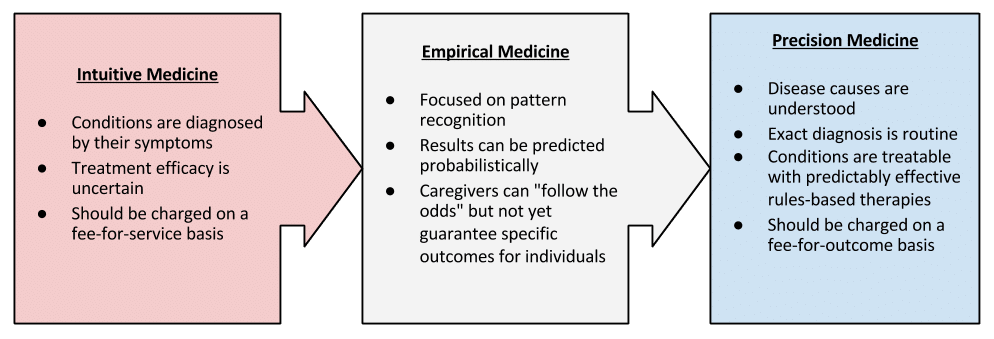Devin Bean, a research assistant at the Clayton Christensen Institute, and I coauthored this piece.
Will reducing health care spending lead to a reduction in health care quality? This is true of many mature industries that depend on sustaining innovations for growth. However, in health care this logic is wrong. We can have higher quality care at much lower cost, and disruptive innovation theory explains how. The secret lies in the way medical science nudges diseases from the realm of intuitive medicine into empirical medicine and finally to precision diagnosis and treatment.
Intuitive medicine
The treatment of tuberculosis, for example, underwent a series of changes in the past century that resulted in cheaper and more effective outcomes for patients. Through the early 1900s, tuberculosis was in the realm of intuitive medicine, where diagnosis and treatment are based on experts’ intuition about the meaning of symptoms and efficacy of treatments.
A patient at that time with persistent coughing, weight loss, fatigue, and fever would likely have been diagnosed with “consumption”. Unfortunately, the human body has a limited vocabulary of symptoms (e.g. pain, fever, nausea, fatigue), so many diseases share common manifestations. We now know that consumption represented a whole family of diseases, including tuberculosis, bronchitis, pneumonia, and lung cancer. Without precision tests to identify tuberculosis, doctors had to rely on their expert knowledge and honed sense of intuition to diagnose this deadly disease. Once diagnosed, they relied on trial-and-error treatment until, hopefully, something worked for the patient.
Empirical medicine
Around the 1920s tuberculosis entered the realm of empirical medicine, where pattern recognition can correlate between actions and outcomes in probabilistic terms. Articles began to appear that quantified responses to tuberculosis treatment: “75% of the patients were admitted only once, 36.9% were discharged and alive at the end of the period of observation, 11.2% were alive on discharge but died during the period of observation, and 26.6% were dead on discharge after their first admission,” reads one report on sanatorium effectiveness (H. E. Hilleboe, Public Health Reports Vol. 56, No. 17 (Apr. 25, 1941), pp. 895-907). Tools developed earlier such as the stethoscope, x-ray, and Mantoux skin test enabled clinicians to better describe and diagnose tuberculosis. Still, though caregivers could “follow the odds,” they could not guarantee treatment outcomes for any individual patient.
Precision medicine
In the mid-20th century, a series of discoveries brought tuberculosis into the domain of precision medicine, where diseases are predictably diagnosed and the root cause reliably treated. Building on an understanding of the bacterial cause of tuberculosis, researchers discovered a host of effective antibiotics, including streptomycin in 1944, isoniazid in 1952, and rifampin in 1963. Combined with the Mantoux skin test developed in 1907 and other diagnostic tools, these technologies finally enabled medical workers to effectively combat tuberculosis.
Higher quality at lower cost
Not only did the movement toward precision medicine allow for more effective tuberculosis treatment, it also reduced costs. Sending people to sanatoriums, one of the most common treatments for tuberculosis through the 1930s, involved a dedicated inpatient facility with full-time staff and treatment personnel. Surgery often accompanied sanatorium stays. These treatments were significantly more expensive (and much less effective) than even the intensive rounds of antibiotics now used to treat the disease. This is true for most precision medicine conditions—once the cause of the disease can be precisely diagnosed and treated, that disease can usually be treated in lower acuity settings using simpler, more effective therapies administered by less-credentialed (and less expensive) clinicians.
Other industries have seen similar cost reductions coupled with quality increases from this same pattern of progress from intuitive to empirical, to precision diagnosis and treatment of problems. DuPont, for example, dominated the synthetic fiber industry early on in large part because they employed most of the brilliant, highly-trained chemists and materials scientists in America. Their intuitive work brought us Nomex, Kevlar, and other synthetic fibers that we use almost daily. As the field of materials science progressed, however, scientists were able to codify which arrangements of molecules and specific chemical bonds defined a polymer’s strength, melting point, and stiffness. That codification, eventually software-assisted, now allows a masters-trained scientist to create higher quality synthetic fibers much more quickly and cheaply than could be done by the world’s foremost experts 100 years ago.
Recommendations
Practitioners and policy makers can do much to help accelerate the progression of diseases from intuitive, to empirical, to precision medicine conditions and unleash disruptive innovation in the health care system. Some suggestions on how to accelerate this process include:
- NIH should prioritize funding of research and diagnostics for intuitive conditions. Diseases can’t move to precision medicine until the causal mechanism of the disease is understood, and that can’t happen without precision diagnostics (e.g. the Mantoux skin test for tuberculosis).
- FDA ought to allow clinical trials to be incorporated as an integral part of the drug development R&D process. This will accelerate pattern recognition and allow more feedback into causal understanding and disease detection.
- Health-care executives must pioneer new business models that treat precision medicine conditions in the lowest cost, lowest acuity setting possible (eventually at the patient’s home).
The victory against vexing diseases is rarely complete. In 1970, the first recorded case of multi-drug resistant tuberculosis appeared, nudging the disease away from the precision medicine state. Nonetheless, in confronting both this and other challenges, continual progress in medical science paired with innovative business models will prove to be the right therapy to make our health care both affordable and effective.



